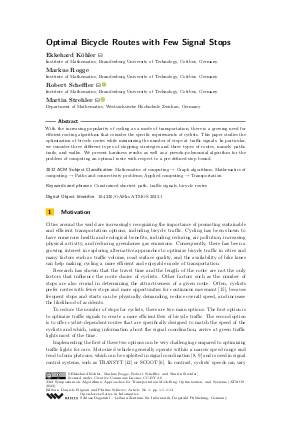Optimal Bicycle Routes with Few Signal Stops
Authors
Ekkehard Köhler,
Markus Rogge,
Robert Scheffler  ,
Martin Strehler
,
Martin Strehler 
-
Part of:
Volume:
23rd Symposium on Algorithmic Approaches for Transportation Modelling, Optimization, and Systems (ATMOS 2023)
Part of: Series: Open Access Series in Informatics (OASIcs)
Part of: Conference: Symposium on Algorithmic Approaches for Transportation Modelling, Optimization, and Systems (ATMOS) - License:
 Creative Commons Attribution 4.0 International license
Creative Commons Attribution 4.0 International license
- Publication Date: 2023-08-31
File

PDF
OASIcs.ATMOS.2023.1.pdf
- Filesize: 0.62 MB
- 14 pages
Document Identifiers
Subject Classification
ACM Subject Classification
- Mathematics of computing → Graph algorithms
- Mathematics of computing → Paths and connectivity problems
- Applied computing → Transportation
Keywords
- Constrained shortest path
- traffic signals
- bicycle routes
Metrics
- Access Statistics
-
Total Accesses (updated on a weekly basis)
0PDF Downloads0Metadata Views
Abstract
With the increasing popularity of cycling as a mode of transportation, there is a growing need for efficient routing algorithms that consider the specific requirements of cyclists. This paper studies the optimization of bicycle routes while minimizing the number of stops at traffic signals. In particular, we consider three different types of stopping strategies and three types of routes, namely paths, trails, and walks. We present hardness results as well as a pseudo-polynomial algorithm for the problem of computing an optimal route with respect to a pre-defined stop bound.
Cite As Get BibTex
Ekkehard Köhler, Markus Rogge, Robert Scheffler, and Martin Strehler. Optimal Bicycle Routes with Few Signal Stops. In 23rd Symposium on Algorithmic Approaches for Transportation Modelling, Optimization, and Systems (ATMOS 2023). Open Access Series in Informatics (OASIcs), Volume 115, pp. 1:1-1:14, Schloss Dagstuhl – Leibniz-Zentrum für Informatik (2023)
https://doi.org/10.4230/OASIcs.ATMOS.2023.1
BibTex
@InProceedings{kohler_et_al:OASIcs.ATMOS.2023.1,
author = {K\"{o}hler, Ekkehard and Rogge, Markus and Scheffler, Robert and Strehler, Martin},
title = {{Optimal Bicycle Routes with Few Signal Stops}},
booktitle = {23rd Symposium on Algorithmic Approaches for Transportation Modelling, Optimization, and Systems (ATMOS 2023)},
pages = {1:1--1:14},
series = {Open Access Series in Informatics (OASIcs)},
ISBN = {978-3-95977-302-7},
ISSN = {2190-6807},
year = {2023},
volume = {115},
editor = {Frigioni, Daniele and Schiewe, Philine},
publisher = {Schloss Dagstuhl -- Leibniz-Zentrum f{\"u}r Informatik},
address = {Dagstuhl, Germany},
URL = {https://drops.dagstuhl.de/entities/document/10.4230/OASIcs.ATMOS.2023.1},
URN = {urn:nbn:de:0030-drops-187628},
doi = {10.4230/OASIcs.ATMOS.2023.1},
annote = {Keywords: Constrained shortest path, traffic signals, bicycle routes}
}
Author Details
References
- Ravindra K. Ahuja, James B. Orlin, Stefano Pallottino, and Maria Grazia Scutellà. Minimum time and minimum cost-path problems in street networks with periodic traffic lights. Transportation Science, 36(3):326-336, 2002. URL: https://doi.org/10.1287/trsc.36.3.326.7827.
- Yen-Liang Chen and Hsu-Hao Yang. Minimization of travel time and weighted number of stops in a traffic-light network. European Journal of Operational Research, 144(3):565-580, 2003. URL: https://doi.org/10.1016/S0377-2217(02)00148-0.
- Stuart E. Dreyfus. An appraisal of some shortest-path algorithms. Operations Research, 17(3):395-412, 1969. URL: https://doi.org/10.1287/opre.17.3.395.
-
Michael R. Garey and David S. Johnson. Computers and Intractability. W. H. Freeman, 29th edition, 2002.

- Refael Hassin. Approximation schemes for the restricted shortest path problem. Mathematics of Operations research, 17(1):36-42, 1992. URL: https://doi.org/10.1287/moor.17.1.36.
-
P. B. Hunt, D. I. Robertson, R. D. Bretherton, and R. I. Winton. SCOOT - A traffic responsive method of coordinating signals. Technical Report Report No. LR 1014, Transport and Road Research Lab, Crowthorne, Berkshire, UK, 1981.

- Alexander Kleff, Frank Schulz, Jakob Wagenblatt, and Tim Zeitz. Efficient Route Planning with Temporary Driving Bans, Road Closures, and Rated Parking Areas. In Simone Faro and Domenico Cantone, editors, 18th International Symposium on Experimental Algorithms (SEA 2020), volume 160 of LIPIcs, pages 17:1-17:13, Dagstuhl, Germany, 2020. Schloss Dagstuhl-Leibniz-Zentrum für Informatik. URL: https://doi.org/10.4230/LIPIcs.SEA.2020.17.
- Ekkehard Köhler and Martin Strehler. Traffic signal optimization: Combining static and dynamic models. Transportation Science, 53(1):21-41, 2019. URL: https://doi.org/10.1287/trsc.2017.0760.
- Ekkehard Köhler, Rolf Möhring, Klaus Nökel, and Gregor Wünsch. Optimization of signalized traffic networks. In Mathematics - Key Technology for the Future, pages 179-188. Springer, 2008. URL: https://doi.org/10.1007/978-3-540-77203-3_13.
- Ariel Orda and Raphael Rom. Shortest-path and minimum-delay algorithms in networks with time-dependent edge-length. Journal of the ACM, 37(3):607-625, 1990. URL: https://doi.org/10.1145/79147.214078.
- Ariel Orda and Raphael Rom. Minimum weight paths in time-dependent networks. Networks, 21(3):295-319, 1991. URL: https://doi.org/10.1002/net.3230210304.
-
Dennis I. Robertson. TRANSYT: A traffic network study tool. Technical Report Report No. LR 253, Transport and Road Research Lab, Crowthorne, Berkshire, UK, 1969.

-
Markus Rogge. Berechnung kürzester Wege unter Berücksichtigung periodischer Ampelschaltungen für FahrradfahrerInnen. Master’s thesis, Brandenburg University of Technology, Cottbus, Germany, 2021. In German.

- Robert Scheffler and Martin Strehler. Optimizing traffic signal settings for public transport priority. In Gianlorenzo D'Angelo and Twan Dollevoet, editors, 17th Workshop on Algorithmic Approaches for Transportation Modelling, Optimization, and Systems (ATMOS 2017), volume 59 of OASIcs, pages 9:1-9:15, Dagstuhl, Germany, 2017. Schloss Dagstuhl-Leibniz-Zentrum für Informatik. URL: https://doi.org/10.4230/OASIcs.ATMOS.2017.9.
- Ipek N. Sener, Naveen Eluru, and Chandra R. Bhat. An analysis of bicycle route choice preferences in Texas, US. Transportation, 36:511-539, 2009. URL: https://doi.org/10.1007/s11116-009-9201-4.
- Liang Shen, Hu Shao, Ting Wu, Emily Zhu Fainman, and William H.K. Lam. Finding the reliable shortest path with correlated link travel times in signalized traffic networks under uncertainty. Transportation Research Part E: Logistics and Transportation Review, 144:102159, 2020. URL: https://doi.org/10.1016/j.tre.2020.102159.
- Martin Strehler, Sören Merting, and Christian Schwan. Energy-efficient shortest routes for electric and hybrid vehicles. Transportation Research Part B: Methodological, 103:111-135, 2017. URL: https://doi.org/10.1016/j.trb.2017.03.007.
- Dean B. Taylor and Hani S. Mahmassani. Coordinating traffic signals for bicycle progression. Transportation Research Record, 1705(1):85-92, 2000. URL: https://doi.org/10.3141/1705-13.
- Tim Zeitz. NP-hardness of shortest path problems in networks with non-FIFO time-dependent travel times. Information Processing Letters, 179:106287, 2023. URL: https://doi.org/10.1016/j.ipl.2022.106287.
